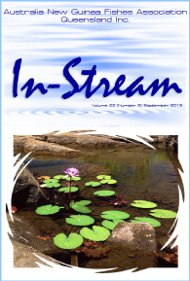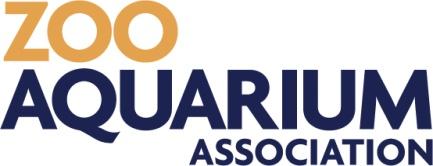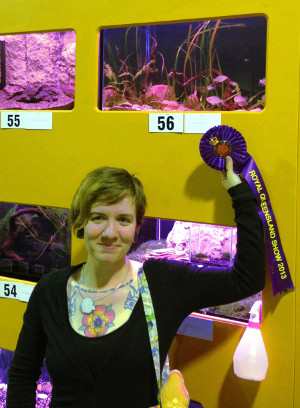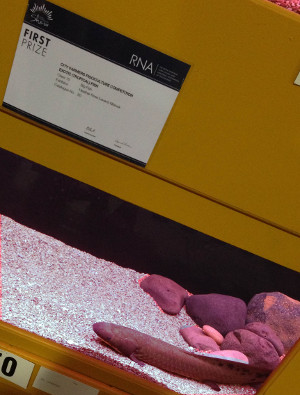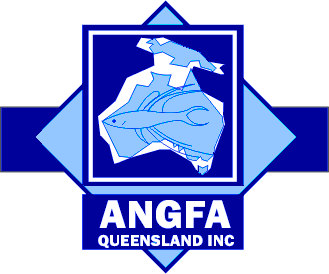 [s2If current_user_can(access_s2member_level1)]It’s that time of year again! The AGM is on December 13 with the general meeting, and members will be asked to vote in a new committee for 2014. If you’d like to nominate yourself or another member for a committee position please contact us with the name of the nominee and a seconder as well as the position the nomination is for.
[s2If current_user_can(access_s2member_level1)]It’s that time of year again! The AGM is on December 13 with the general meeting, and members will be asked to vote in a new committee for 2014. If you’d like to nominate yourself or another member for a committee position please contact us with the name of the nominee and a seconder as well as the position the nomination is for.
[/s2If][s2If !current_user_can(access_s2member_level1) && is_user_logged_in()]Sorry, your account isn’t currently enabled as an ANGFA Qld member. If you’ve only just registered and/or joined please be patient as all the ANGFA Qld staff are volunteers and it may take a few days to update and verify our records. If you think there’s a problem with your account please let us know so that we can look into it.[/s2If][s2If !is_user_logged_in()]Sorry, this content is restricted to members of ANGFA Qld. Log in or register if you’d like to access this content.[/s2If]
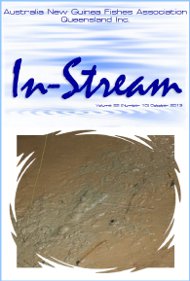 In this issue of In-Stream we travel with Adrian Tappin west of the Great Dividing Range on Cape York Peninsula in Far North Queensland to visit the Ducie River as it makes its way into the Gulf of Carpentaria.
In this issue of In-Stream we travel with Adrian Tappin west of the Great Dividing Range on Cape York Peninsula in Far North Queensland to visit the Ducie River as it makes its way into the Gulf of Carpentaria.
We also get up close and personal with some the most beautiful, interesting and/or unusual inhabitants of Australian freshwaters (and sometimes aquaria). This time the focus is on Blind Cave Gudgeons, Giant Jungle Prawns (Macrobrachium lar), Blue Stream Gobies (Sicyopterus lagocephalus), and Mudmat (Glossostigma).
Make sure you find the cryptic creature featured in the cover photograph of this issue too – just another example of what makes Australia waterways so special 😉 .
As always, if you have an interesting story or photo to share we’d love to hear about it – so please contact us if you’d like to contribute to In-Stream.
In-Stream September is out now!
In this edition we go fish sampling on Mabiaug Island with seasoned field biologist Glynn Aland who’s found Threadfin Mangrovegobies (Mugilogobius filifer), freshwater crabs (Austrothelphusa sp.) and an unusual form of Pacific Blue-eye (Psuedomugil signifer).
There’s a close up of the Macquarie Turtle (Emydura macquarii).
Our esteemed editor takes us on a river tour in New South Wales where we’ll see the Hastings River and the Camden Haven River. And Adrian will take a special look at some fish foods, from culturing paramecia to selecting a commercial product.
Hopefully enough to tide you over to the convention and our next meeting (which has been postponed to October 18th because of the convention).
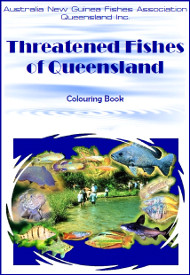 In recognition of National Threatened Species Day 2013, ANGFA Qld have produced a colouring in book depicting some of Queensland’s threatened freshwater fish – for free download. With original art from Rose Levanti-Niblock, photos from Gunther Schmida, and editing by Adrian Tappin the book includes a colouring-in section and a section with some facts and photos about the featured fish that will help teachers and parents provide more information for enquiring minds.
In recognition of National Threatened Species Day 2013, ANGFA Qld have produced a colouring in book depicting some of Queensland’s threatened freshwater fish – for free download. With original art from Rose Levanti-Niblock, photos from Gunther Schmida, and editing by Adrian Tappin the book includes a colouring-in section and a section with some facts and photos about the featured fish that will help teachers and parents provide more information for enquiring minds.
Inside you’ll find Queensland’s:
- Red-finned Blue-eye (Scaturiginichthys vermeilipinnis);
- Edgbaston Goby (Chlamydogobius squamigenus);
- Honey Blue-eye (Pseudomugil mellis);
- Ornate Rainbowfish (Rhadinocentrus ornatus);
- Oxleyan Pygmy Perch (Nannoperca oxleyana);
- Jungle Perch (Kuhlia rupestris); and
- Lungfish (Neoceratodus forsteri).
Please feel free to pass a link to this page on to teachers, schools and anyone else you think might be interested. ANGFA Qld promotes a better understanding of our native fish and the waterways they live in.
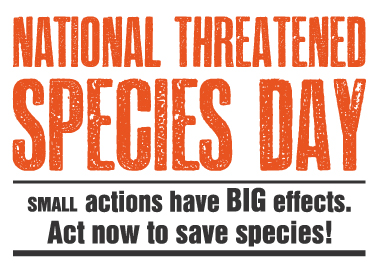
Events Friday September 6, 2013 (please note the actual day is September 7)
National Threatened Species Day first occurred in 2007 after Frank Manthey, Co-Founder, Save the Bilby Fund and Al Mucci, Director of Dreamworld embarked on a vision: to collectively harness the zoo and aquaria industry to draw attention to the plight of our national threatened species.
 National Threatened Species Day has since run with great success in Queensland. This year, the event has expanded to a number of other states in Australia.
National Threatened Species Day has since run with great success in Queensland. This year, the event has expanded to a number of other states in Australia.
Free community events are being held across New South Wales, Queensland, and Northern Territory.
ANGFA Qld has produced a Threatened Fish Colouring Book as part of the event this year.
WHO: ANGFA Qld is joining with zoos and aquariums across Australia for this National Threatened Species Day in partnership with the Save the Bilby Fund. Featuring celebrity ambassadors, Frank Manthey ‘The Bilby Man’ and Ranger Stacey.
WHAT: Over 30 zoos and aquariums, under the banner of the Zoo and Aquarium Association will bring a range of iconic, quirky, creepy and slithery threatened species into city locations across the nation. This FREE event will inspire and educate local communities about the plight of threatened species.
Have your photo taken with a Tassie Devil, cuddle a koala, pat a Dingo pup etc!
Experience a close encounter with a variety of live threatened species.

WHEN: 8am – 2pm, with 10 – 15 minute interactive and fun presentations by keepers with their animals.
WHERE: Friday Sept 6 – Sydney (Martin Place) and Brisbane (Queen Street Mall, CBD); Sunday September 1 – Cairns (Carnival on Collins); and Saturday September 7 Darwin (Waterfront)
WHY: The Zoo and Aquarium Association connects zoos and aquariums throughout Australasia in a network for conservation. We will inspire local communities to find out what is threatening many of our species, and educate them on what we can all do in our daily lives to help save them.
The Zoo and Aquarium Association connects 90 member zoos and aquariums in a network for conservation. Together, with the Australian Government, and other conservation organisations such as the Save the Bilby Fund we are working to protect and conserve these threatened species through species management programs, and education.
The collective vision of the Zoo and Aquarium Association members is to harness the membership for conservation. Together our aim is to prevent the extinction of species.
Why 7th September?
The date for National Threatened Species Day, (7th September) commemorates the last day that the Tasmanian Tiger was alive in 1936. Now, 76 years later, Australia is still facing the extinction of many threatened species including Australia’s very own Bilby and Tasmanian Devil.
The Value of Australian Zoos and Aquariums
- Zoos and aquariums are the second most popular cultural activity in Australia with over 15 million visitors annually, second only to the cinema;
- they contribute to the education of over 600,000 students per annum;
- they rescue and rehabilitate on average over 14,000 Australian animals each year; and
- they care for 370 species on the International Union Conservation for Conservation of Nature (IUCN) red list of endangered species.
What are zoos doing for our threatened species?
Currently, zoos and aquariums are working with government in every state and territory in Australia to participate in recovery efforts for some of the country’s most endangered wildlife. For example, zoos are the only viable solution to saving the Tasmanian Devil through the Insurance Population, a captive breeding program in partnership with the Tasmanian Government.
Zoo and Aquarium Association
- Zoo and Aquarium Association is the peak body for zoos and aquariums with over 70 member zoos in Australasia.
- The Association has coordinated National Threatened Species Day.
- The Association currently run more than 100 managed programs for rare and threatened species.
Extinctions are a natural part of evolution however there is no excuse for man-made extinctions. We must all act together to prevent the extinction of any more of our wonderful and amazing species.
www.zooaquarium.org.au
 Original story by Amy McCosker, ABC Rural
Original story by Amy McCosker, ABC Rural
If you thought the Ekka was just for led livestock competitions you’d be mistaken.
Every year 10,000 animals come to the show and breeders and enthusiasts of all kinds come from far and wide to show off their animals.

Pisciculturalist Steve Banes with his furnished community tank entry at the Ekka pisciculture competition. Steve called this tank his ”Community Sink”.
Fish enthusiasts, or pisciculturalists, have gathered with 200 fish and other aquatic wildlife ranging from common goldfish to tropical species, as well as Australian freshwater natives, crustaceans, and amphibians.
Fish lover Steve Banes has literally bought everything including the kitchen sink in an attempt win the competition this year.
“I’ve replicated a kitchen sink with the tap constantly running and it’s see through on the front so you can see the fish swimming amongst the dishes,” he says of his contribution to the show.
“The judges are looking for the ability of the fish to live harmoniously together as a community.
“People ask why we have fish as pets but they don’t don’t bite the postman, they don’t pee on the carpet and they don’t annoy the neighbours.”
It hasn’t always been an easy ride for the aquatic breeders who have had to fight to be taken seriously.
“A few years ago we approached the RNA, they have champion cow, champion horse, champion goat so we said ‘why can’t we have a champion fish?'”
“We marched in the grand parade for the first time four years ago and we definitely get the best cheer.
“We all dress in full suits and we get our face painted to make it a bit colourful and as you walk around you dodge the cow and horse poo.”
Mr Banes says leading a fish around a parade takes some ingenuity.
“We have the fish in a cup on a lanyard around out neck and we have it well covered with cling film.”
Kept a safe distance from the fish is the Poultry, Pigeons, Birds and Eggs display.
While the traditional runner ducks, laying hens and turkeys are always interesting it’s the birds known as ‘dinosaurs’ that many come to see.
Desley Krause is the owner of the chickens officially known as Australian Game which stand upright at almost a metre on strong, powerful legs leading to their prehistoric nickname.
“I was walking past one one day and I said ‘oh that’s ugly but I’ve got to have one,’ and that was twenty years ago and I’ve still got them,” she says.
“Temperament wise they are just absolutely beautiful, there is nothing drastic about them.”
Kept all the way over on the other side of the show are the dogs.
These pampered pooches have their own show ring so together with their owners they can display some skills for the judges.
Italian Greyhound breeder Maureen Friend whose winning pup was wearing a sparkling collar made of crystal beads that would make many human divas jealous.
“I won best of breed with my girl, she’s the love of my life,” she says.
After many years showing horses and now dogs Mrs Friend says there are perks to breeding smaller animals.
“It’s definitely easier, there is less mess to clean up.”
ANGFA Queensland member Rose Levanti-Niblock has done extremely well in this years RNA Pisciculture Competiton with her two native freshwater fish displays.
Tadpole the Lungfish
Taking first place in the Big Fish Category was Rose’s pride and joy “Tadpole”, a 6yr old Queensland lungfish (Neoceratodus forsteri). Tadpole usually lives at home in an all native 5 foot tank with a 20cm archerfish (Toxotes sp.), another lungfish, two bass (Macquaria novemaculeata), two red/spotted scats (Scatophagus argus) and two purple-spot gudgeons (Mogurnda sp.). Rose hand feeds Tadpole, Massivore delite, sinking granules, algae wafers, crayfish, fish, snails and a homemade seafood and veggie mix.
Tadpole was entered into the Big Fish category, which allows for large fish that wouldn’t fit into the show at their full size (as long as they’re at least 20cm at time of judging), and won first place.
Rose purchased tadpole 18 months ago from Ceratodus.com. His parents were wild caught and he is microchipped to prove he was captive bred as lungfish are a no-take species under Queensland law and there trade is restricted by CITES. Fossils similar to the lungfish date back 380 million years, approximately the time when higher vertebrate classes began evolving. It has remained virtually unchanged for at least 100 million years. The only natural populations occur in Queensland’s Mary and Burnett river systems.
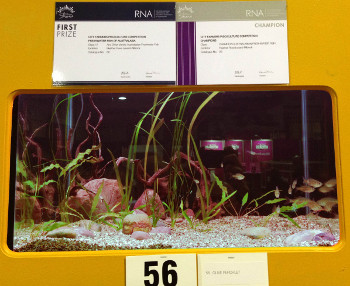
Ambassis agassizii display. Winner of the “Australasian Native Fish: Any Other Variety” class (essentially native non-rainbow fish) and champion of the Australasian Native Fish category.
Champion Australasian Native Fish: Olive Perchlets
Rose also entered a group of Olive Perchlets (Ambassis agassizii) into the “Any Other Variety” class of the Australasian native category. Not only did the Olive Perchlets win their class, they held their own against Australian and New Guinea rainbowfishes entered by previous winners to take out the category as Champion Australasian Native Fish!
Rose’s display included 5 full size (65 mm), 8 medium, and 6 tiny Olive Perchlets that were “by-product” from a local crayfish farm, otherwise destined to be used to feed other peoples pets anlongside firetail gudgeons… The 2 foot display tank was furnished with red river gravel, river rocks, and vine wood. It was planted with native Vallisneria nana, Potamogeton perfoliatus, some exotic crypts and other plants.
Congratulations Rose, it’s great to see some other native fish giving the rainbows more than just a run for their money!
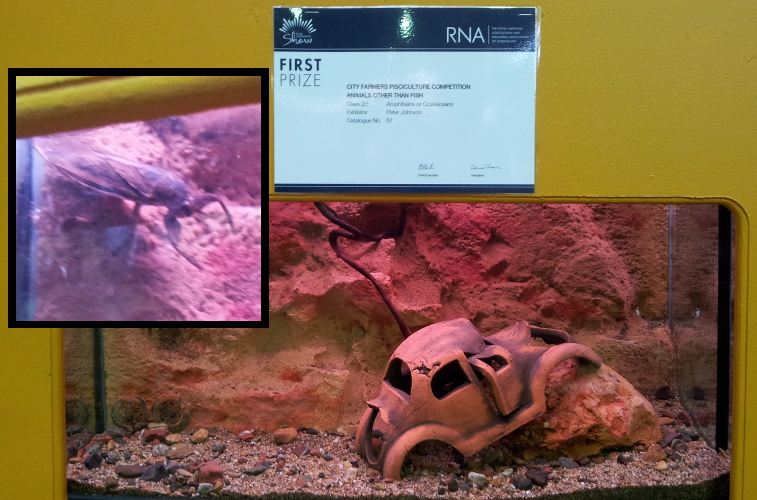
Lethocerus insulanus – Giant Water Bug, Fish Killer or Toe Biter entered in the ‘Animals Other Than Fish’ category of the RNA Show, pisciculture competition.
First time entrant in the RNA Pisciculture competition (and ANGFA Queensland Secretary) Peter Johnson has received first prize in the ‘Animals other than fish’ category of the show for a 7 cm Giant Water Bug (Lethocerus insulanus). The display was put together by ANGFA Queensland President, Steve Baines.
Giant Water Bugs (Australia’s largest aquatic insect) are ambush predators. They will remain camouflaged until an unsuspecting fish, frog or other prey item moves within reach at which time they grasp and hold it, mantis style, with their powerful front legs. The syringe-like mouthparts are thrust into the prey allowing venom and digestive acid to be pumped into it. The bug will then suck the fluids from the prey, casting aside the carcass when done. Ekka steward Bill Smith described this behaviour as being remarkably similar to that of his friend’s ex-wife.
Giant Water Bugs are one of the few native animals capable of preying upon juvenile cane toads and cane toad tadpoles. Checkout the profile at the Australian Museum.
This YouTube video demonstrates the predatory behaviour of a juvenile European cousin of Lethocerus insulanus.
ANGFA Annual General Meeting Friday 11 October, 2013 8:00PM
Notice is hereby given that the ANGFA Annual General Meeting will be held at 8:00PM on Friday 11 October of the National Convention held at Ciloms Convention Venue, location Melrose Drive, Tullamarine Victoria.
As per our constitution, all Committee Members will stand down at the AGM and their positions will become vacant. This gives members the opportunity to elect to office whomever they feel is best suited for the position.
All Nominees, Proposers, Seconders and Voters must be current financial members. If you haven’t yet paid your dues, please do so now. The nomination which shall be in writing and signed by the member and his proposer and seconder, shall be lodged with the secretary at least forty-five days before the Annual General Meeting. Closing date is Tuesday 27 August.
The Committee recognises that in order for ANGFA to flourish, the continual regeneration of ANGFA Committee with new and enthusiastic members that represent the wider interest of the association is needed. If you would like to be involved with the Committee or have any queries, please do not hesitate to contact a current Committee member or myself directly.
Yours Faithfully,
Gerard Carmody
Hon Secretary
ANGFA Inc. (Australia New Guinea Fishes Association Incorporated)
Email secretary@angfa.org.au
P.O. Box 1040, Richmond North,
Victoria 3121, Australia

